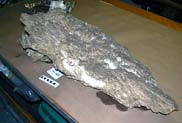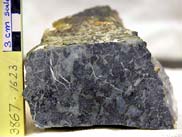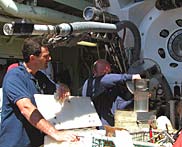|
|
||||||||||||||||||||||||||||||||||||||||||||||||||||||||||||||||||||||||||||||||||||||||||||||||||||
 |
||||||||||||||||||||||||||||||||||||||||||||||||||||||||||||||||||||||||||||||||||||||||||||||||||||
|
The Beautiful and Intriguing Rocks of Lost City (Les magnifiques et interessantes roches de "la cite perdue")
Every morning, it's with real pleasure that I wake up to see the launch of Alvin, hoping that it will bring back a lot of samples, and every afternoon I’m waiting impatiently for its return to look at the collected samples from Lost City. Alvin takes several kinds of samples: water samples, biologic samples, and rock samples. My interest is in the rock samples. My specialty on this cruise is the petrology and the geochemistry, and my “job” is to describe the rocks collected from the Lost City after each dive. I cut them, after a short description, in order to describe them in detail, and to learn about their history: where they come from, what were the conditions of formation, what kind of alteration do they display? However, the on-board description is succinct, and additional analyses will be performed in the laboratory on land (bulk, mineralogical, and isotopic compositions) and these analyses are essential to answer our questions and allow us to better understand the involved processes in the formation of the Lost City and how the alteration of the rocks controls the hydrothermal activity of the Lost City.
The samples collected at each dive amaze me. Imagine looking at and having in your hand rocks coming from the depth of the ocean: it’s magic!! And it’s even more surprising when I cut these samples. The carbonate vent structures display unbelievable textures that are very hard to describe; it’s kind of like a superposition of white crumpled papers or the inside of a wasp's nest.
The basement samples (peridotite, gabbro, serpentinites) are also amazing, because outside they look like the same thing—blocks covered by a black manganese crust. However, when they are cut in half, they display a large variety of textures, mineralogy and alteration.
Today is our 10th Alvin dive, and Tim Shank wanted to take biology samples, so a strange machine, the 'hydraulic slurp', was mounted in front of Alvin. It's like a vacuum cleaner which sucks up life around Lost City. And when Alvin came up, the 'big slurp' seems to have worked very well. A lot of work is ahead of the biologists tonight!! I thought this morning that there would be no rock samples, however, Tim collected 3 vent carbonate samples, including a huge one that smells of H2S (it's like a rotten egg) and has a new interesting texture (to be continued) P.S.: I'm the only French person on this cruise, and my English is not very good, and my knowledge of the American culture too. So, everyday I try a new thing to eat (Oreos, real hamburgers, Dr Pepper (soon), muffins, pancake) but I haven't yet tried the traditional peanut butter and jelly sandwich... and I'm not really looking forward to trying it... sorry! And I try to learn new words and to change my French accent. But there is a word too difficult to say for me: it's 'squirrel'. And the American people laugh at me, but it's also difficult for you to say the French word 'ecureuil' (squirrel). Try to say it !! |
||||||||||||||||||||||||||||||||||||||||||||||||||||||||||||||||||||||||||||||||||||||||||||||||||||



